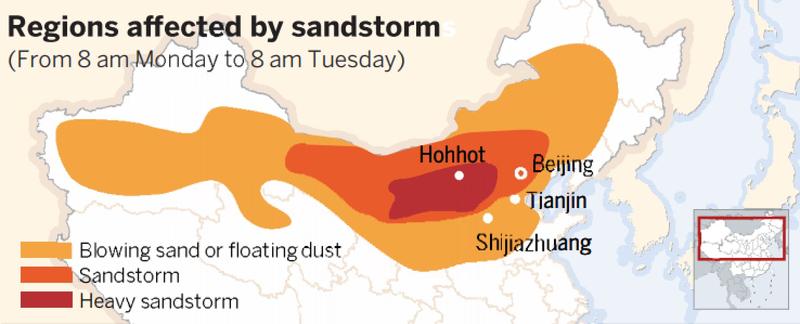 Commuters brave a sandstorm in Beijing on Monday. The capital, together with many regions in northern China, experienced the strongest sandstorm in nearly a decade, according to the National Meteorological Center. (FENG YONGBIN / CHINA DAILY)
Commuters brave a sandstorm in Beijing on Monday. The capital, together with many regions in northern China, experienced the strongest sandstorm in nearly a decade, according to the National Meteorological Center. (FENG YONGBIN / CHINA DAILY)
A sand and dust storm from Mongolia swept through northern areas of China on Monday and led to the suspension of classes at schools and flight cancellations.
The sandstorm was the strongest in nearly a decade and affected 12 provincial-level regions in northern China, according to the National Meteorological Center.
The sandstorm was the strongest in nearly a decade and affected 12 provincial-level regions in northern China, according to the National Meteorological Center
Remote sensing images showed the storm covered an area of 466,000 square kilometers, including Beijing and Tianjin, the Inner Mongolia autonomous region and Hebei, Shanxi, Gansu, Shaanxi, Liaoning, Jilin and Heilongjiang provinces.
Visibility remained lower than 500 meters in some areas of northern China as the center issued a yellow alert, the lowest level in the three-tier weather alert system, on Monday morning.
READ MORE: Sandstorm blankets northwest China's Ningxia
At 8 pm on Monday, the level of PM10 particles in Beijing dropped to 864 micrograms per cubic meter in six major urban districts, down from 8,108 micrograms per cubic meter at 9 am, according to the Beijing Ecological and Environment Monitoring Center.
Dust and snowstorms are frequent in the spring in Mongolia.
At least nine people were killed in a heavy dust and snowstorm in Mongolia over the weekend, the country's National Emergency Management Agency said on Monday.
The Mongolian agency said that 579 of the 590 people who got lost in the storm were found alive.
Searches were underway for the remaining missing people, it said.
Many yurts-traditional tent dwellings-and power lines were taken down in the storm in several provinces, especially in Dundgovi province, the agency added.
In Manzhouli and Baotou, in China's Inner Mongolia autonomous region, schools suspended their classes on Monday due to the sandstorm.
The airport in Manzhouli was also temporarily closed for safety reasons at noon on Monday, according to the city's authorities.
Related departments and rescue workers in the city were on 24-hour standby, the authorities said.
Hohhot, capital of Inner Mongolia, has upgraded its alert for sandstorm to orange, the second-highest in the three-tiered warning system.
As of 4:40 pm, Beijing Capital International Airport canceled 46 flights and Beijing Daxing International Airport canceled eight flights due to the sandstorm, according to the airports.
The capital's educational authority has requested all schools and educational institutions to suspend outdoor activities.
 (NATIONAL METEOROLOGICAL CENTER / CHINA DAILY)
(NATIONAL METEOROLOGICAL CENTER / CHINA DAILY)
China Meteorological Administration forecast that the sandstorm will continue until Tuesday in Shandong, Hebei, Gansu provinces and the Inner Mongolia autonomous region. On Wednesday, the wind and the sandstorm will taper off as rainfall comes to the Yangtze and Huaihe river regions.
Zhang Bihui, a senior official at the administration, said little cold air and a lack of rainfall created the conditions for the sandstorm.
 A man braves a sandstorm in Beijing on March 15, 2021. (ZHU XINXING / CHINA DAILY)
A man braves a sandstorm in Beijing on March 15, 2021. (ZHU XINXING / CHINA DAILY)
ALSO READ: 2nd sandstorm in a week blows east from desert
"Temperatures in Mongolia and northwestern China remained 5 to 8 C higher than the same period of normal years. Little rain in the region caused the dry conditions which were favorable for the sandy and dusty weather", Zhang said.
Shi Yan, an analyst from Tianqi.com, said that in spring vegetation coverage in northern areas has not had time to grow and the ground is barren, and sand and dust are easily blown up into the air.
"Wind has lifted sand and dust to a high altitude so that its transmission distance could be far," she said.
From 1981 to 2010, the capital had an annual average of 2.4 days of dust and sandstorms in March. The longest sandstorm so far this century occurred in 2001 with nine days. The most recent one was in April 2015, the capital's observatory said.
Zheng Caixiong, Du Juan, Ma Chi and Xinhua contributed to this story.


